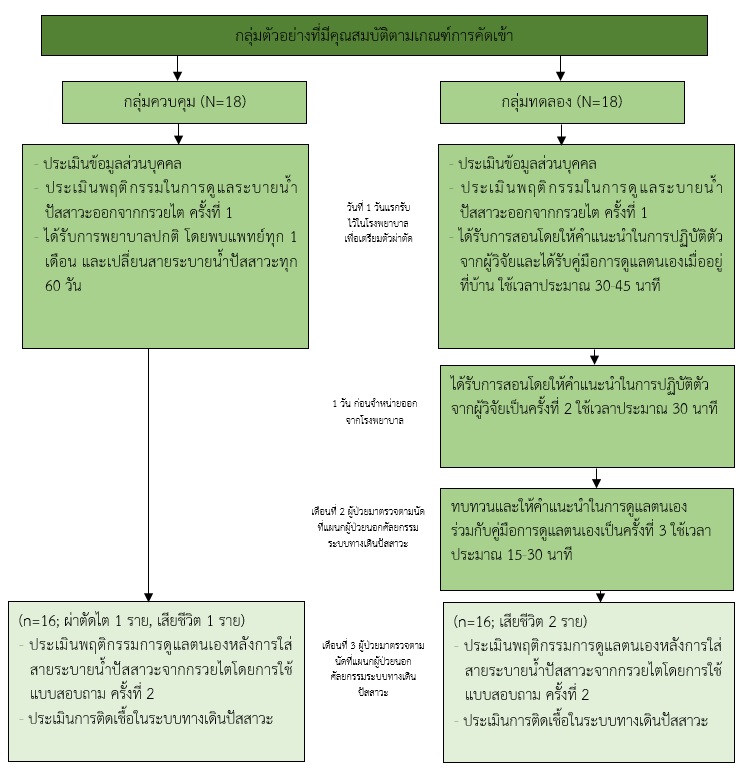ผลของการสอนโดยให้คำแนะนำร่วมกับการใช้คู่มือการดูแลตนเอง ต่อพฤติกรรมการดูแลตนเองและอัตราการติดเชื้อ ในผู้ป่วยใส่สายระบายน้ำปัสสาวะออกจากกรวยไต
คำสำคัญ:
การสอน, พฤติกรรมการดูแลตนเอง, สายการระบายน้ำปัสสาวะออกจากกรวยไต, การติดเชื้อบทคัดย่อ
การวิจัยกึ่งทดลองแบบสองกลุ่มวัดก่อนและหลังการทดลอง มีวัตถุประสงค์เพื่อเปรียบเทียบพฤติกรรมการดูแลตนเองหลังการใส่สายระบายน้ำปัสสาวะและอัตราการติดเชื้อหลังการใส่สายระบายน้ำปัสสาวะออกจากกรวยไต ระหว่างกลุ่มผู้ป่วยที่ได้รับการสอนโดยให้คำแนะนำร่วมกับการใช้คู่มือการดูแลตนเองกับกลุ่มที่ได้รับการดูแลตามปกติ กลุ่มตัวอย่าง คือ ผู้ป่วยที่ได้รับการผ่าตัดใส่สายระบายน้ำปัสสาวะออกจากกรวยไตผ่านผิวหนัง โรงพยาบาลเชียงรายประชานุเคราะห์ คัดเลือกกลุ่มตัวอย่างที่มีคุณลักษณะตามเกณฑ์ และแบ่งเข้ากลุ่มทดลองและกลุ่มควบคุม กลุ่มละ 16 ราย เครื่องมือวิจัย ประกอบด้วย แผนการสอนโดยให้คำแนะนำการดูแลตนเองหลังการใส่สายระบายน้ำปัสสาวะออกจากกรวยไต คู่มือการดูแลตนเอง แบบสอบถามพฤติกรรมการดูแลตนเอง และแบบบันทึกการติดเชื้อหลังผ่าตัด ติดตามผลหลังการศึกษาในเดือนที่ 3 วิเคราะห์ข้อมูลโดยใช้สถิติบรรยาย การทดสอบ Wilcoxon Sign-Ranks test สถิติ Mann-Whitney U test และ Fisher’s Exact test ผลการวิจัย พบว่า
กลุ่มทดลองมีคะแนนพฤติกรรมการดูแลตนเองหลังการใส่สายระบายน้ำปัสสาวะออกจากกรวยไตสูงกว่าก่อนศึกษาอย่างมีนัยสำคัญทางสถิติที่ระดับ .001 จากกรวยไตสูงกว่าก่อนศึกษาอย่างมีนัยสำคัญทางสถิติที่ระดับ .001 และมีผลต่างของคะแนนเฉลี่ยพฤติกรรมการดูแลตนเองหลังการใส่สายระบายน้ำปัสสาวะออกจากกรวยไตก่อนและหลังการศึกษาสูงกว่ากลุ่มควบคุมอย่างมีนัยสำคัญทางสถิติที่ระดับ .01 และมีอัตราการ ติดเชื้อร้อยละ 12.5 ซึ่งน้อยกว่ากลุ่มควบคุมที่มีอัตราการติดเชื้อที่ร้อยละ 75 อย่างมีนัยสำคัญทางสถิติที่ระดับ .001
การสอนโดยให้คำแนะนำร่วมกับการใช้คู่มือการดูแลตนเองมีประสิทธิภาพในการลดอัตราการติดเชื้อในระบบทางเดินปัสสาวะและเพิ่มความสามารถในการดูแลตนเองของผู้ป่วยที่ใส่สายระบายน้ำปัสสาวะออกจากกรวยไต
เอกสารอ้างอิง
Azer, S. Z., Mohsen, S. A. A.-E., & Sayed, S. Y. (2018). The Effect of Nursing Guidelines on Minimizing Incidence of Complications for Patients with Percutaneous Nephrostomy Tube. American Journal of Nursing Research, 6(5), 327-334.
Cheumthonh, P., Kimsungnoen, N., & Namjuntra, R. (2020). The Effects of Educative Supportive Program on Self Care Behavior and HbA1C in Persons Newly Diagnosed with Type 2 Diabetes. Journal of Nursing Science & Health, 43(1), 78-86. (in Thai)
Chiangraiprachanukhro Hospital. (2015). Statistics of Operative Patients. Retrieved September 13, 2015 from https://www.crhospital.org/home/index1.php?group=12
Dagli, M., & Ramchandani, P. (2011). Percutaneous Nephrostomy: Technical Aspects and Indications. Seminars in interventional radiology, 28(4), 424-437.
El Haddad, H., Viola, G., Jiang, Y., Raad, I., Rolston, K. V., & Szvalb, A. (2017). Percutaneous Nephrostomy Tube-related Infections. Open Forum Infectious Diseases, 4(suppl1), S349-S349.
Fernández-Cacho, L. M., & Ayesa-Arriola, R. (2019). Quality of Life, Pain and Anxiety in Patients with Nephrostomy Yubes. Revista Latino-Americana de Enfermagem, 27. Retrieved November 16, 2019 from http://www.scielo.br/scielo.php?script=sci_arttext&pid=S0104-11692019000100371&nrm=iso
Ganter Ritz, V., Speroni, K. G., & Walbridge, D. (2016). Reducing Complications and Hospitalizations Through an Innovative Catheter Care Clinic for Percutaneous Nephrostomy Catheter Patients. Journal of Radiology Nursing, 35(4), 275-280.
Halle, M. P., Toukep, L. N., Nzuobontane, S. E., Ebana, H. F., Ekane, G. H., & Priso, E. B. (2016). The Profile of Patients with Obstructive Uropathy in Cameroon: Case of the Douala General Hospital. The Pan African medical journal, 23, 67-67.
Huang, S. Y., Philip, A., Richter, M. D., Gupta, S., Lessne, M. L., & Kim, C. Y. (2015). Prevention and Management of Infectious Complications of Percutaneous Interventions. Seminars in interventional radiology, 32(2), 78-88.
Jones, L. F., Meyrick, J., Bath, J., Dunham, O., & McNulty, C. A. M. (2019). Effectiveness of Behavioural Interventions to Reduce Urinary Tract Infections and Escherichia Coli Bacteraemia for Older Adults Across all Care Settings: A Systematic Review. J Hosp Infect, 102(2), 200-218.
Maramara, B., Lob'o, Z., & Psevdos, G. (2018). Epidemiology of Nephrostomy Tube–Related Urinary Tract Infections Among US Veterans. Infectious Diseases in Clinical Practice, 26(6), 344-347.
Orem, D. E., Taylor, S. G., & Renpenning, K. M. (2001). Nursing: Concepts of Practice. St. Louis: Mosby.
Pabon-Ramos, W. M., Dariushnia, S. R., Walker, T. G., d'Othée, B. J., Ganguli, S., Midia, M. et al. (2016). Quality Improvement Guidelines for Percutaneous Nephrostomy. J Vasc Interv Radiol, 27(3), 410-414.
Siddiq, D. M., & Darouiche, R. O. (2012). Infectious Complications Associated with Percutaneous Nephrostomy Catheters: Do We Know Enough? Internation Journal of Artificial Organs, 35(10), 898-907.
Tang, X., & Lieske, J. C. (2014). Acute and Chronic Kidney Injury in Nephrolithiasis. Current Opinion in Nephrology and Hypertension, 23(4), 385-390.
Taylor, E., Miller, S., Chi, T., & Stoller, M. L. (2012). Complications Associated with Percutaneous Nephrolithotomy. Translational Andrology and Urology, 1(4), 223-228.
Thitisak, P., Hunnirun, P., & Ponsuwan, P. (2011). The Effectiveness of Health Education Program Applying the Self-efficacy Theory on Percutaneous Nephrostomy Patients in Bhumiboladulyadej Hospital. Journal of Faculty of Physical Education, 14(1), 203-213. (in Thai)
Tseng, T. Y., & Stoller, M. L. (2009). Obstructive Uropathy. Clinical Geriatric Medicine, 25(3), 437-443.
Turo, R., Horsu, S., Broome, J., Das, S., Gulur, D. M., Pettersson, B. et al. (2018). Complications of Percutaneous Nephrostomy in a District General Hospital. Turkish Journal of Urology, 44(6), 478-483.
Wongngam, W., Sucamvang, K., & Nanasilp, P. (2014). Effect of Educative-Supportive Nursing on Self-care Behaviors of the Elderly with Hip Fracture During Recovery Stage. Nursing Jouranl, 41(2), 72-82. (in Thai)

ดาวน์โหลด
เผยแพร่แล้ว
ฉบับ
ประเภทบทความ
สัญญาอนุญาต
1. บทความหรือข้อคิดเห็นใด ๆ ที่ปรากฏในวารสารเครือข่าย วิทยาลัยพยาบาลและการสาธารณสุขภาคใต้ ที่เป็นวรรณกรรมของผู้เขียน บรรณาธิการหรือเครือข่ายวิทยาลัยพยาบาลและวิทยาลัยการสาธารณสุขภาคใต้ ไม่จำเป็นต้องเห็นด้วย
2. บทความที่ได้รับการตีพิมพ์ถือเป็นลิขสิทธิ์ของ วารสารเครือข่ายวิทยาลัยพยาบาลและการสาธารณสุขภาคใต้







